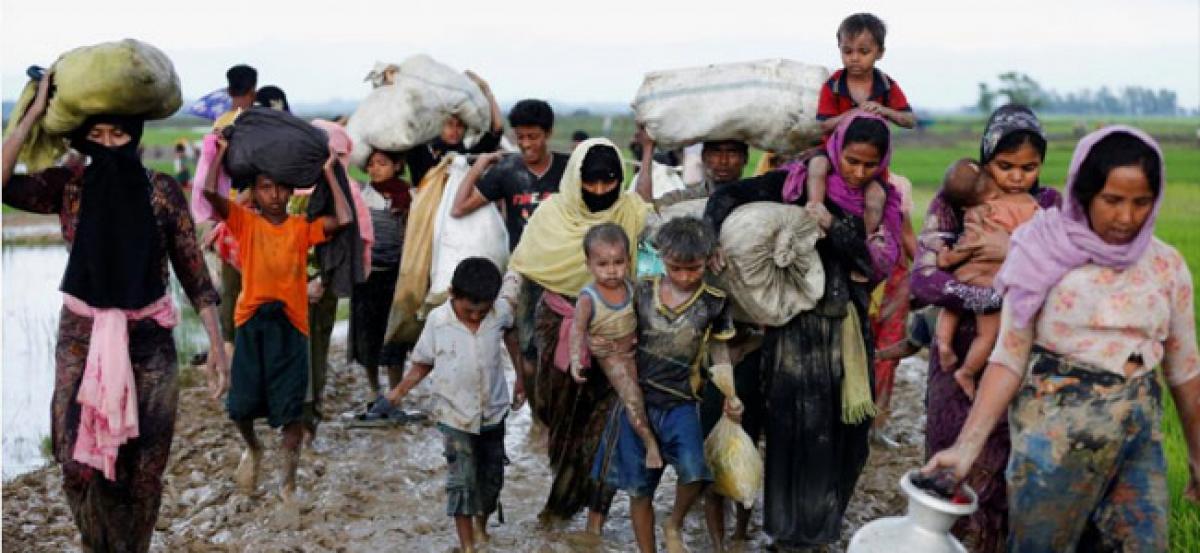Live
- First Impressions and Unboxing of the MacBook Pro M4: A Powerhouse for Professionals and Creators
- China Gears Up for Potential Trade War Amid Trump’s Tariff Threats
- Small Farmers Gain Less by Selling to Supermarkets: Study Reveals
- Why Despite the Controversy, America Is Anticipating the Mike Tyson vs. Jake Paul Fight
- Sanju Samson and Tilak Varma Shine: Record-Breaking Feats in 4th T20I Against South Africa
- India Urges $1.3 Trillion Annual Climate Support for Developing Nations
- Bad air: 106 shuttle buses, 60 extra Metro trips planned to make Delhiites give up cars
- WHO reports declining monkeypox cases in Congo
- CM Attends Kotideepotsavam on Kartika Purnima
- PKL Season 11: Raiding trio of Devank, Ayan, Sandeep help Patna Pirates rout Bengal Warriorz
Just In

More than 2,600 houses have been burned down in Rohingya-majority areas of Myanmar’s northwest in the last week, the government said on Saturday, in one of the deadliest bouts of violence involving the Muslim minority in decades.
COX‘S BAZAR, Bangladesh: More than 2,600 houses have been burned down in Rohingya-majority areas of Myanmar’s northwest in the last week, the government said on Saturday, in one of the deadliest bouts of violence involving the Muslim minority in decades.
About 58,600 Rohingya have fled into neighbouring Bangladesh from Myanmar, according to U.N. refugee agency UNHCR, as aid workers there struggle to cope.
Myanmar officials blamed the Arakan Rohingya Salvation Army (ARSA) for the burning of the homes. The group claimed responsibility for coordinated attacks on security posts last week that prompted clashes and a large army counter-offensive.
But Rohingya fleeing to Bangladesh say a campaign of arson and killings by the Myanmar army is aimed at trying to force them out.
The treatment of Myanmar’s roughly 1.1 million Rohingya is the biggest challenge facing leader Aung San Suu Kyi, accused by Western critics of not speaking out for the Muslim minority that has long complained of persecution.
The clashes and army crackdown have killed nearly 400 people and more than 11,700 “ethnic residents” have been evacuated from the area, the government said, referring to the non-Muslim residents.
It marks a dramatic escalation of a conflict that has simmered since October, when a smaller Rohingya attack on security posts prompted a military response dogged by allegations of rights abuses.
“A total of 2,625 houses from Kotankauk, Myinlut and Kyikanpyin villages and two wards in Maungtaw were burned down by the ARSA extremist terrorists,” the state-run Global New Light of Myanmar said. The group has been declared a terrorist organisation by the government.
But Human Rights Watch, which analysed satellite imagery and accounts from Rohingya fleeing to Bangladesh, said the Myanmar security forces deliberately set the fires.“New satellite imagery shows the total destruction of a Muslim village, and prompts serious concerns that the level of devastation in northern Rakhine state may be far worse than originally thought,” said the group’s deputy Asia director, Phil Robertson.
FULL CAPACITY
Near the Naf river separating Myanmar and Bangladesh, new arrivals in Bangladesh carrying their belongings in sacks set up crude tents or tried to squeeze into available shelters or homes of locals.
“The existing camps are near full capacity and numbers are swelling fast. In the coming days there needs to be more space,” said UNHCR regional spokeswoman Vivian Tan, adding more refugees were expected.
The Rohingya are denied citizenship in Myanmar and regarded as illegal immigrants, despite claiming roots that date back centuries. Bangladesh is also growing increasingly hostile to Rohingya, more than 400,000 of whom live in the poor South Asian country after fleeing Myanmar since the early 1990s.
Jalal Ahmed, 60, who arrived in Bangladesh on Friday with a group of about 3,000 after walking from Kyikanpyin for almost a week, said he believed the Rohingya were being pushed out of Myanmar.
“The military came with 200 people to the village and started fires...All the houses in my village are already destroyed. If we go back there and the army sees us, they will shoot,” he said.
Reuters could not independently verify these accounts as access for independent journalists to northern Rakhine has been restricted since security forces locked down the area in October.
Speaking to soldiers, government staff and Rakhine Buddhists affected by the conflict on Friday, army chief Min Aung Hlaing said there is no “oppression or intimidation” against the Muslim minority and “everything is within the framework of the law”.
“The Bengali problem was a long-standing one which has become an unfinished job,” he said, using a term used by many in Myanmar to refer to the Rohingya that suggests they come from Bangladesh.
Many aid programmes running in northern Rakhine prior to the outbreak of violence, including life-saving food assistance by the World Food Programme (WFP), have been suspended since the fighting broke out.
“Food security indicators and child malnutrition rates in Maungdaw were already above emergency thresholds before the violence broke out, and it is likely that they will now deteriorate even further,” said Pierre Peron, spokesman for the U.N. Office for the Coordination of Humanitarian Affairs in Myanmar.
More than 80,000 children may need treatment for malnutrition in northern Rakhine and many of them reported “extreme” food insecurity, WFP said in July.
In Bangladesh, Tan of UNHCR said more shelters and medical care were needed. “There’s a lot of pregnant women and lactating mothers and really young children, some of them born during the flight. They all need medical attention,” she said.
Among new arrivals, 22-year-old Tahara Begum gave birth to her second child in a forest on the way to Bangladesh.
“It was the hardest thing I’ve ever done,” she said.

© 2024 Hyderabad Media House Limited/The Hans India. All rights reserved. Powered by hocalwire.com







